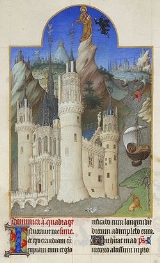
Château de Mehun-sur-Yèvre
Encyclopedia
The Château de Mehun-sur-Yèvre is a castle in the town of Mehun-sur-Yèvre in the départment
of Cher, France
.
The castle is classified as a Monument historique
since 1840.
in 1367. Largely ruined in the 18th century the castle represented an excellent example of late Gothic architecture
and early Renaissance architecture
. Charles VII of France
, died in the castle July 22, 1461.
.jpg)
or donjon. The keep and the west tower still stand to their full height, each capped with intricate defensive machicolations. Manuscript illustrations indicate that the castle also had a large chapel above the principal entrance.
Department
A department is a part of a larger organization with a specific responsibility. For the division of organizations into departments, see departmentalization.In particular:...
of Cher, France
France
The French Republic , The French Republic , The French Republic , (commonly known as France , is a unitary semi-presidential republic in Western Europe with several overseas territories and islands located on other continents and in the Indian, Pacific, and Atlantic oceans. Metropolitan France...
.
The castle is classified as a Monument historique
Monument historique
A monument historique is a National Heritage Site of France. It also refers to a state procedure in France by which national heritage protection is extended to a building or a specific part of a building, a collection of buildings, or gardens, bridges, and other structures, because of their...
since 1840.
History
The existence of a fortification at the site of Mehun-sur-Yèvre dates from antiquity. The major remains are of the early 13th century and the later 14th century. The present standing ruins date from a castle founded under the Courtenays after 1209. This fortress was transformed into a princely residence by John, Duke of BerryJohn, Duke of Berry
John of Valois or John the Magnificent was Duke of Berry and Auvergne and Count of Poitiers and Montpensier. He was the third son of King John II of France and Bonne of Luxemburg; his brothers were King Charles V of France, Duke Louis I of Anjou and Duke Philip the Bold of Burgundy...
in 1367. Largely ruined in the 18th century the castle represented an excellent example of late Gothic architecture
Gothic architecture
Gothic architecture is a style of architecture that flourished during the high and late medieval period. It evolved from Romanesque architecture and was succeeded by Renaissance architecture....
and early Renaissance architecture
Renaissance architecture
Renaissance architecture is the architecture of the period between the early 15th and early 17th centuries in different regions of Europe, demonstrating a conscious revival and development of certain elements of ancient Greek and Roman thought and material culture. Stylistically, Renaissance...
. Charles VII of France
Charles VII of France
Charles VII , called the Victorious or the Well-Served , was King of France from 1422 to his death, though he was initially opposed by Henry VI of England, whose Regent, the Duke of Bedford, ruled much of France including the capital, Paris...
, died in the castle July 22, 1461.
.jpg)
Description of the Chateau
The castle is built on a trapezoid plan, and originally had a tall cylindrical tower at each corner and a rectangular tower in the middle of one of the long sides. An entrance was formed in the wall between two of the towers. One tower (12m diameter), was much larger than the others (8m), and served as the keepKeep
A keep is a type of fortified tower built within castles during the Middle Ages by European nobility. Scholars have debated the scope of the word keep, but usually consider it to refer to large towers in castles that were fortified residences, used as a refuge of last resort should the rest of the...
or donjon. The keep and the west tower still stand to their full height, each capped with intricate defensive machicolations. Manuscript illustrations indicate that the castle also had a large chapel above the principal entrance.

